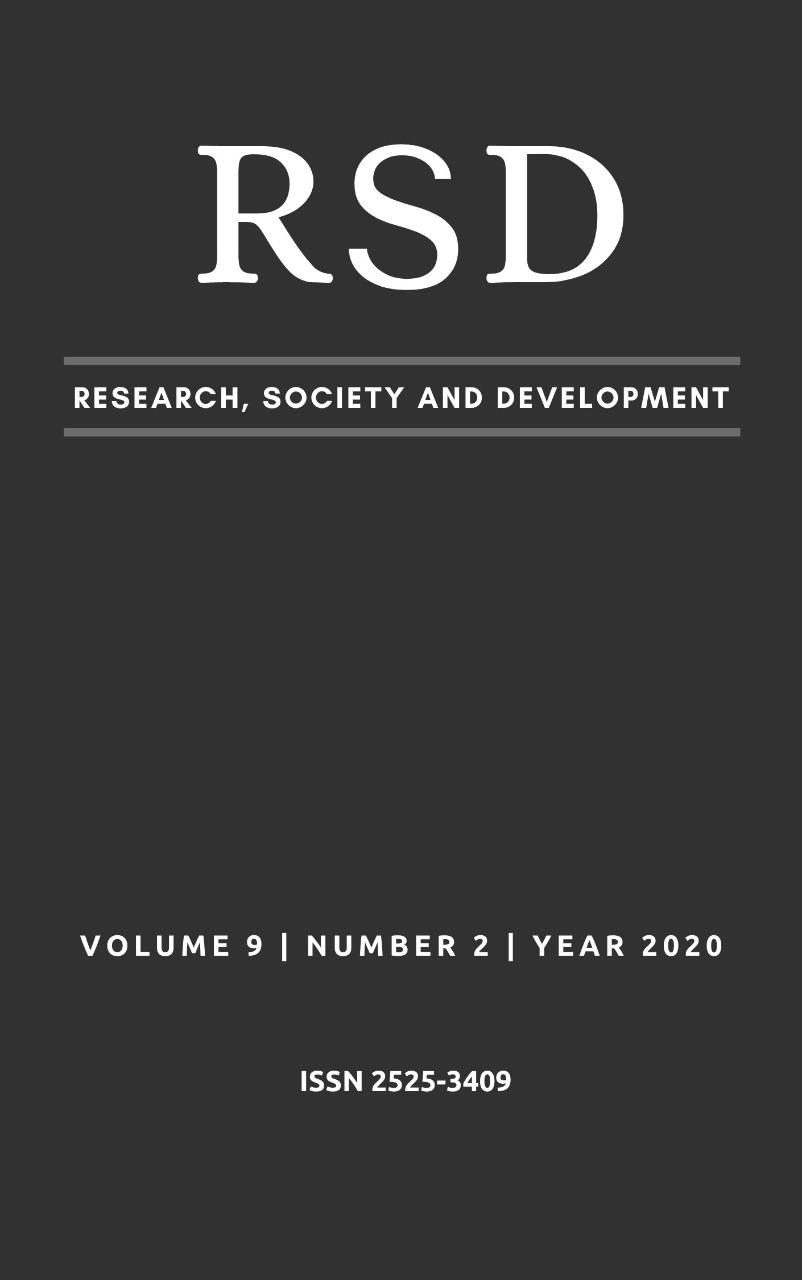Docking molecular do complexo de rutênio com epiisopiloturina e óxido nítrico frente à proteína nucleoside diphosphate kinase da Leishmania
DOI:
https://doi.org/10.33448/rsd-v9i2.2121Palavras-chave:
Biologia Computacional, Anti-Infecciosos, Trypanosomatina.Resumo
A leishmaniose é uma doença infecciosa que afeta animais e humanos, causada por parasitas flagelados pertencentes ao gênero Leishmania, podendo apresentar-se em diferentes formas clínicas, dependendo da cepa infectante e da reação imune do hospedeiro. Estima-se que a doença atinja cerca de 700.000 a 1 milhão de pessoas, causando a morte de 20 a 30.000 indivíduos anualmente. Assim, o presente estudo tem como objetivo realizar uma simulação de acoplamento molecular do complexo de rutênio com epiisopiloturina e óxido nítrico contra a proteína Nucleosídeo difosfato cinase de Leishmania amazonensis. A molécula em 3D NDK foi extraída do banco de dados de proteínas e ácidos nucleicos PDB. A estrutura molecular 3D do complexo Epiruno2 foi projetada usando o software gaussview 5.0. O alvo NDK e o complexo Epiruno2 foram preparados para simulações de ancoragem, onde o NDK foi considerado rígido e o Epiruno2 foi considerado flexível. O complexo Epiruno2 apresentou boa taxa de afinidade molecular com a proteína alvo, tornando-o atrativo para ensaios experimentais em laboratórios para a proteína NDK da Leishmania e NDKs de outros patógenos, no entanto, o fármaco miltefosina apresentou baixa afinidade molecular para o mesmo alvo, corroborando com estudos apresentados na literatura sobre a eficácia reduzida dos medicamentos atuais contra a leishmaniose.Referências
Berman, H. M. et al. (2000). The Protein Data Bank. Nucleic Acids Res, 28:235-242.
Boucher, H. W. et al. (2009). Bad bugs, no drugs: no ESKAPE! An update from the Infectious Diseases Society of America. Clinical infectious diseases, 48(1):1-12.
Cosconati, S. et al. (2010). Virtual screening with AutoDock: theory and practice. Expert opinion on drug discovery, 5(6):597-607.
Dennington, R.; Keith, T.; Millam, J. (2009). GaussView, Version 5.0. 8, R.
Frisch, M. J. et al. (2009). Gaussian 09, Revision D. 01, Gaussian. Inc.: Wallingford, CT.
Garbin, S. et al. (2015). Complexos de rutênio (II) contendo 2- mercaptoimidazol e derivados: síntese, caracterização e avaliação da atividade biológica.
Goodsell, D. S.; Morris, G. M.; Olson, A. J. (1996). Automated docking of flexible ligands: applications of AutoDock. Journal of Molecular Recognition, 9(1):1-5.
Kantor, J. D. et al. (1993). Inhibition of cell motility after nm23 transfection of human and murine tumor cells. Cancer research, 53(9):1971-1973.
Kasbekar, N. (2006). Tigecycline: a new glycylcycline antimicrobial agent. American journal of health-system pharmacy, 63(13):1235-1243.
Khamesipour, A. (2014). Therapeutic vaccines for leishmaniasis. Expert opinion on biological therapy, 14(11):1641-1649.
Kohn, W.; Sham, L. J. (1965). Self-consistent equations including exchange and correlation effects. Physical review, 140(4A):A1133.
Lacombe, M. L. et al. (2000). The human Nm23/nucleoside diphosphate kinases. Journal of bioenergetics and biomembranes, 32(3):247-258.
Macdonald, N. J. et al. (1993). A serine phosphorylation of Nm23, and not its nucleoside diphosphate kinase activity, correlates with suppression of tumor metastatic potential. Journal of Biological Chemistry, 268(34):25780-25789.
Macedo, T. S. et al. (2017). Platinum (ii)–chloroquine complexes are antimalarial agents against blood and liver stages by impairing mitochondrial function. Metallomics, 9(11):1548-1561.
Meng, Xuan-Yu. et al. (2011). Molecular docking: a powerful approach for structure-based drug discovery. Current computer-aided drug design, 7(2):146-157.
Mishra, A. K. et al. (2017). Discovery of novel inhibitors for Leishmania nucleoside diphosphatase kinase (NDK) based on its structural and functional characterization. Journal of computer-aided molecular design, 31(6):547-562.
Morris, G. M. et al. (1998). Automated docking using a Lamarckian genetic algorithm and an empirical binding free energy function. Journal of computational chemistry, 19(14):1639-1662.
Parks, R. E. et al. (1973). Purine metabolism in primitive erythrocytes. Comparative Biochemistry and Physiology--Part B: Biochemistry and, 45(2):355-364.
Perryman, A. L. et al. (2015). A virtual screen discovers novel, fragment-sized inhibitors of Mycobacterium tuberculosis InhA. Journal of chemical information and modeling, 55(3):645-659.
Ramos, R. M. et al. (2012). Interaction of wild type, G68R and L125M isoforms of the arylamine-N-acetyltransferase from Mycobacterium tuberculosis with isoniazid: a computational study on a new possible mechanism of resistance. Journal of molecular modeling, 18(9):4013-4024.
Rocha, J. A. et al. (2018). Computational quantum chemistry, molecular docking, and ADMET predictions of imidazole alkaloids of Pilocarpus microphyllus with schistosomicidal properties. PloS one, 13(6):e0198476.
Rojas, R. et al. (2006). Resistance to antimony and treatment failure in human Leishmania (Viannia) infection. The Journal of infectious diseases, 193(10):1375-1383.
Sánchez-delgado, R. A. et al. (1998). Toward a novel metal based chemotherapy against tropical diseases 4. Synthesis and characterization of new metal-clotrimazole complexes and evaluation of their activity against Trypanosoma cruzi. Inorganica chimica acta, 275:528-540.
Solis, F. J.; Wets, R. J.-B. (1981). Minimization by random search techniques. Mathematics of operations research, 6(1):19-30.
Srivastava, S. K.; Rajasree, K.; Gopal, B. (2011). Conformational basis for substrate recognition and regulation of catalytic activity in Staphylococcus aureus nucleoside di-phosphate kinase. Biochimica et Biophysica Acta (BBA)-Proteins and Proteomics, 1814(10):1349-1357.
Theuretzbacher, U. (2009). Future antibiotics scenarios: is the tide starting to turn?. International journal of antimicrobial agents, 34(1):15-20.
WHO. Control of Leishmaniasis Report of a meeting of the WHO Committee of Experts on the Control of Leishmaniasis. 2019. Available from: http://www.who.int/mediacentre/factsheets/fs375/en/
Downloads
Publicado
Edição
Seção
Licença
Autores que publicam nesta revista concordam com os seguintes termos:
1) Autores mantém os direitos autorais e concedem à revista o direito de primeira publicação, com o trabalho simultaneamente licenciado sob a Licença Creative Commons Attribution que permite o compartilhamento do trabalho com reconhecimento da autoria e publicação inicial nesta revista.
2) Autores têm autorização para assumir contratos adicionais separadamente, para distribuição não-exclusiva da versão do trabalho publicada nesta revista (ex.: publicar em repositório institucional ou como capítulo de livro), com reconhecimento de autoria e publicação inicial nesta revista.
3) Autores têm permissão e são estimulados a publicar e distribuir seu trabalho online (ex.: em repositórios institucionais ou na sua página pessoal) a qualquer ponto antes ou durante o processo editorial, já que isso pode gerar alterações produtivas, bem como aumentar o impacto e a citação do trabalho publicado.


